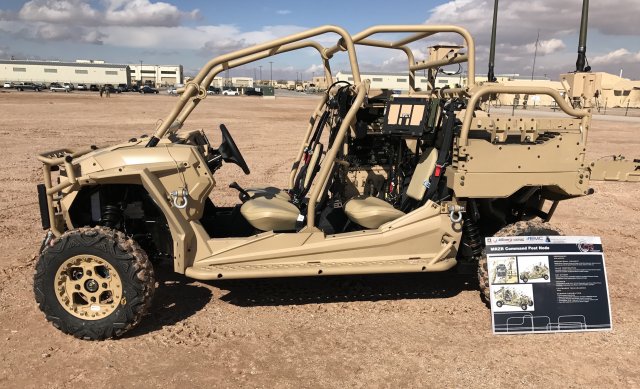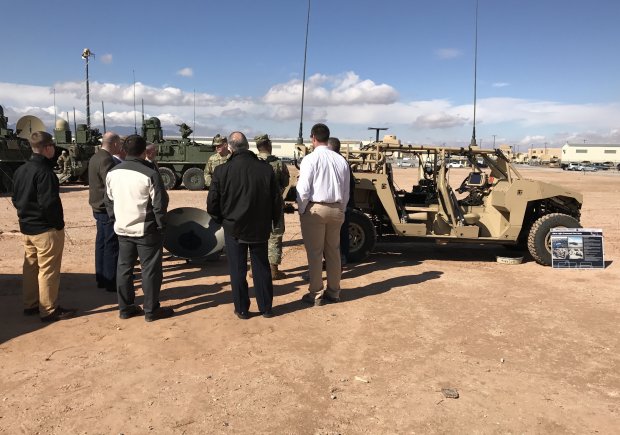
Kathryn Bailey, CERDEC CP&I
FORT BLISS, Texas (February 27, 2017) — The U.S. Army Forces Command, or FORSCOM, recently hosted a Command Post Huddle, designed to generate discussions among key Army leaders to help standardize command post requirements.
During the event, FORSCOM’s commanding general, Gen. Robert Abrams, stressed that the Army must act now to insert innovation into command post designs because “the world we’re going to fight in the future is not the same as we’ve been fighting the past 15 years,” and that today’s commands posts must be “more effective, lethal, and survivable.”
The attendees toured several command post configurations on display Fort Bliss, Texas, for the event, including three vehicle-based expeditionary command post demonstrators provided by the U.S. Army Materiel Command’s Communications-Electronics Research, Development and Engineering Center, or CERDEC.
“Our goal was to add value to the Command Post Huddle effort by showing Army leaders more than what units were currently employing in their force structures,” said Doug Hopler, CERDEC engineer. “Inserting innovative R&D paired with Soldier feedback into the requirements gathering process is ultimately good for the Army.”
As the research and development lead for Mission Command, CERDEC is supporting the Command Post Integrated Infrastructure, or CPI2, initiative from within the Program Executive Office for Command, Control Communications-Tactical, or PEO C3T. CPI2 emerged from the Army’s Command Post 2025 Concept of Operations at the Mission Command Center of Excellence in Fort Leavenworth, Kansas, and was created to manage command post capabilities across portfolios. It is expected to become a Program of Record in FY 2019.

Soldiers with the 1st Armored Division, 2nd Armored Brigade Combat Team’s 1st Squadron, 1st Cavalry Regiment Main plan their mission from inside the Lightweight Mobile Command Post TAC during the Network Integration Evaluation/Army Warfighter Assessments, or NIE/AWA, 16.1. The quick erect table and large screen displays are key timesaving enablers for setup and teardown of the command post. (Photo Credit: U.S. Army photo by Edric Thompson, CERDEC)
“Our expeditionary command post capabilities are integrated onto light vehicles to allow Soldiers to quickly move in — and out – yet still have access to the robust mission command systems required to conduct safe and effective operations,” said Tyler Barton, CERDEC’s project lead for Expeditionary Command Post Capabilities, or ECPC. “We’re combining our understanding of mission command needs for the future command post with our design and prototyping capabilities. We believe this effort will help advance the Army’s Force 2025 and Beyond strategy, which provides the nation with a more expeditionary and agile force.”
During the event, Army leaders reviewed command post demonstrators across all echelons to identify how much commonality to build into expeditionary command posts, and how to implement variations when appropriate. They plan to provide feedback to the U.S. Army Training and Doctrine Command, or TRADOC, which will codify the information into formal requirements for future command posts.
CERDEC’s demonstrators, developed for brigade and below, consisted of the Light Mobile Command Post, or L-MCP, the Ultra-light Command Post, or UL CP, and the even lighter Light Tactical Command Post, or LT CP. CERDEC is working closely with several Army units, including the XVIII Air Borne Corps, 82nd Airborne Division, 101st Airborne Division, III Corps, and 1st Armored Division to evaluate the ECPC demonstrators.
The L-MCP is a High Mobility Multipurpose Wheeled Vehicle that features a quick erect tent, roll-out integrated standing height table, chairs, semi-rugged large screen displays, tactical network components and converged voice communications and mission command systems to form a Tactical Command Post, or TAC.
“Whenever the [command post] has to jump, we must fill the void that the operations cell can no longer perform,” said Capt. Benjamin Staats, 1st Armored Division, 2nd Armored Brigade Combat Team. “The L-MCP takes less time than a traditional TAC to breakdown and set up, giving us streamlined, continuous operations and better reconnaissance for the brigade.”

The Light Tactical Command Post node prototype includes a mission equipment configuration built on top of a Polaris MRZR-4D vehicle to provide increased mobility, range and command and control for light forces. (Photo Credit: U.S. Army photo by Tyler Barton, CERDEC CPI)
The iterative development process has allowed engineers to “build a little and test a little” based on Soldier feedback, Hopler said.
The UL CP demonstrator, developed by CERDEC primarily for infantry battalion combat team formations during initial entry operations, utilizes a Polaris DAGOR platform. Its baseline package supports multiple mission types, and includes radios capable of voice and data Radio Cross Banding, Friendly Force Situational Awareness, tactical messaging and Full Motion Imagery while at the halt.
“Our R&D team designed the UL CP to demonstrate a more robust mission command capability and command post functionality on a platform that can keep up with the extreme mobility requirements,” Barton said. “Through iterative demonstrations with operational units, we have gained valuable unit feedback on our design, and we are using that feedback to validate the utility of this type of solution.”
The newest and lightest command post demonstrator, the LT CP, is built on top of a Polaris MRZR-4D vehicle and provides increased mobility, range and command and control for light forces. Soldiers will evaluate the LT CP in the near future.
“The event at Fort Bliss was a great opportunity for us to show our work to the larger Army community during a key time — when the community is baselining its collective requirements,” Barton said. “Our work adds a lot to that conversation.”
This article was originally published on Army.mil.

Col. Greg Coile, project manager for Warfighter Information Network-Tactical (WIN-T), under the Program Executive Office Command, Control and Communications-Tactical (PEO C3T), the discusses Ultra Light Command Post, which utilizes a Polaris DAGOR platform with a current baseline package that includes radios capable of voice and data Radio Cross Banding, Friendly Force Situational Awareness; tactical messaging; and Full Motion Imagery while at the halt. (Photo Credit: U.S. Army photo by Tyler Barton, CERDEC CPI)
Subscribe to Army AL&T News, the premier online news source for the Acquisition, Logistics, and Technology (AL&T) Workforce.







